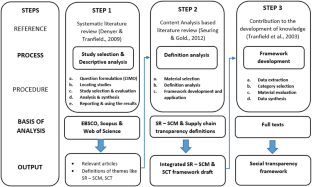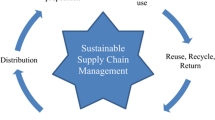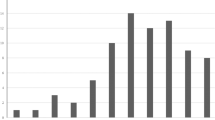Abstract
The current focus in supply chain management (SCM) research revolves around the relationship between sustainability and supply chain transparency (SCT). Despite the three pillars of sustainability – environmental, social, and economic- the limited and scattered analysis is on the social part, and the least is on socially responsible supply chain management (SR-SCM). SCT plays a significant role in elevating the sustainability of the supply chain. This review paper emphasizes the integration of SCT and sustainable supply chain, especially the social aspect as SR-SCM, and coining the new term social transparency (ST). ST is openness to communicating details about the impact of business on people, their well-being, and compliance with social sustainability standards and policies. This paper establishes a conceptual framework using three research methods. systematic literature review, content analysis-based literature review, and framework development. By locating studies in databases like EBSCO, Scopus, and Web of Science, 273 peer-reviewed articles were identified in the intersection of social sustainability, supply chains, and transparency. Finally, the framework proposes five dimensions: tracking and tracing suppliers till provenance, product and process specifications, financial transaction information, social sustainability policies and compliance, and performance assessment to determine ST in global supply chains.





Similar content being viewed by others
Data availability
The data that supports the findings of this systematic literature review and content analysis are either included in this manuscript or are publicly available in the referenced sources. All included studies and their respective citations are provided in the reference section. Any additional data or materials used for this review can be obtained upon request from the corresponding author.
Abbreviations
- SCM:
-
Supply chain management
- SR-SCM:
-
Socially responsible supply chain management
- SCT:
-
Supply Chain Transparency
- ST:
-
Social Transparency
- MNCs:
-
Multinational Corporations
- CoC:
-
Code of Conduct
- CSR:
-
Corporate Social Responsibility
- PRISMA:
-
Preferred Reporting Items for Systematic Reviews and Meta-analyses
- RFID:
-
Radio frequency Identification
- IoT:
-
Internet of Things
- SSCM:
-
Sustainable Supply Chain Management
- SC:
-
Supply Chain
- OEKO TEX:
-
Textile Standard Certification
- WRAP:
-
Worldwide Responsible Accredited Production
- GOTS:
-
Global Organic Textile Standard
- GRS:
-
Global Recycled Standard
- REACH:
-
Registration, Evaluation, Authorization and Restriction on the use of Chemicals
- SA 8000:
-
Social Accountability International Certification
- ISI:
-
Indian Standards Institution Mark
- BIS:
-
Bureau of Indian Standards
References
Abdul S, Khan R, Zkik K, Belhadi A, Kamble SS (2021) Evaluating barriers and solutions for social sustainability adoption in multi-tier supply chains. Int J Prod Res 0(0):1–20. https://doi.org/10.1080/00207543.2021.1876271
Al-Khatib AW (2023) Internet of things, big data analytics and operational performance: the mediating effect of supply chain visibility. J Manuf Technol Manage 34(1):1–24. https://doi.org/10.1108/JMTM-08-2022-0310
Awaysheh A, Klassen RD (2010) The impact of supply chain structure on the use of supplier socially responsible practices. Int J Oper Prod Manage, 30(12)
Bangladesh garment workers (2023) ‘frustrated’ by Gov’t wage hike after protests. The minimum wage increase comes after weeks of the worst protests in a decade hit Bangladesh’s major industrial areas. November 08, [Cited 30.01.2024]. https://www.aljazeera.com/news/2023/11/8/bangladesh-garment-workers-frustrated-by-govts-wage-hike-after-protests#:~:text=Bangladesh&20is&20the&20second&20largest,according&20to&20the&20manufacturers'&20association.
Bangladesh workers’ protest (2023) 150 factories shut, cases against 11k workers. Bangladesh’s garment workers earn $95 a month as minimum wage and are demanding a minimum wage of $208 a month. BS Web Team November 13, [Cited 30.01.2024]. https://www.business-standard.com/world-news/bangladesh-workers-protest-150-factories-shut-cases-against-11k-workers-123111300291_1.html
Bozic D (2015) From Haute Couture to Fast-Fashion: Evaluating Social Transparency in Global Apparel Supply Chains. MIT Thesis
Brun A, Karaosman H, Barresi T (2020) Supply chain collaboration for transparency. Sustain (Switzerland), 12(11)
Carter CR, Rogers DS (2008) A framework of sustainable supply chain management: moving toward new theory. Int J Phys Distribution Logistics Manage
Delaney A, Connor T (2016) Forced Labour in the Textile and Garment Sector in Tamil Nadu, South India Strategies for Redress. October, 1–67. http://corporateaccountabilityresearch.net/njm-report-xiii-sumangali
Denyer D, Tranfield D (2009) Producing a systematic review. In: Buchanan DA, Bryman A (eds) The sage handbook of organizational research methods. Sage Publications Ltd., pp 671–689
Doorey DJ, Doorey DJ (2018) The transparent supply chain: from resistance to implementation at Nike. J Bus Ethics 103(4):587–603
Egels-Zandén N, Hansson N (2016) Supply Chain transparency as a consumer or corporate Tool: the case of Nudie Jeans Co. J Consum Policy 39(4):377–395. https://doi.org/10.1007/s10603-015-9283-7
Egels-Zandén N, Hulthén K, Wulff G (2015) Trade-offs in supply chain transparency: the case of Nudie Jeans Co. J Clean Prod 107:95–104
Elkington J (1998) Accounting for the triple bottom line. Measuring Business Excellence
Fair Labor Association (2012) Understanding the Characteristics of the Sumangali Scheme in Tamil Nadu Textile & Garment Industry and Supply Chain Linkages. May. www.fairlabor.orgwww.solidaridadnetwork.org
Faisal M, Sabir N, Bin L (2023) Operationalizing transparency operationalizing in supply chains using a systematic literature review and graph theoretic approach. https://doi.org/10.1108/BIJ-05-2022-0291
Francisco K, Swanson D (2018) The Supply Chain Has No Clothes: Technology Adoption of Blockchain for Supply Chain Transparency. Logistics
Fraser IJ, Müller M, Schwarzkopf J (2020) Transparency for multi-tier sustainable supply chain management: a case study of a multi-tier transparency approach for SSCM in the automotive industry. Sustain (Switzerland) 12(5):1–24
Hohn MM, Durach CF (2023) Taking a different view: theorizing on firms ’ development toward an integrative view on socially sustainable supply chain management. 53(1), 13–34. https://doi.org/10.1007/s10551-012-1245-2
Huq FA, Stevenson M, Zorzini M (2014) Social sustainability in developing country suppliers an exploratory study in the ready made garments industry of Bangladesh. Int J Oper Prod Manage
Jamalnia A, Gong Y, Govindan K (2023) Sub-supplier’s sustainability management in multi-tier supply chains: a systematic literature review on the contingency variables, and a conceptual framework. Int J Prod Econ 255(January 2022):108671. https://doi.org/10.1016/j.ijpe.2022.108671
Klassen RD, Vereecke A (2012) Social issues in supply chains: capabilities link responsibility, risk (opportunity), and performance. Intern J Prod Econ
Kraft T, Valdés L, Zheng Y (2018) Supply Chain visibility and social responsibility: investigating consumers ’ behaviors and motives. Manufacturing & Service Operations Management
Lamming RC, Caldwell ND, Harrison DA, Phillips W (2001) Transparency in Supply Relationships: Concept and Practice. November, 4–10
Limited KEDSP (2019) Evaluation of Sumangali_Eradication of extremely exploitative working conditions in Southern India’s textile industry. June
Mayer DM, Ong M, Sonenshein S, Ashford S (2019) To Get Companies to Take Action on Social Issues, Emphasize Morals, Not the Business Case. [Website]. [Cited 11.11.2023]. Available: https://hbr.org/2019/02/to-get-companies-to-take-action-on-social-issues-emphasize-morals-not-the-business-case
McGrath P, McCarthy L, Marshall D, Rehme J (2021) Tools and technologies of transparency in sustainable global supply chains. Calif Manag Rev 64(1):67–89
Moher D, Liberati A, Tetzlaff J, Altman DG, Antes G, Atkins D, Barbour V, Barrowman N, Berlin JA, Clark J, Clarke M, Cook D, D’Amico R, Deeks JJ, Devereaux PJ, Dickersin K, Egger M, Ernst E, Gøtzsche PC, Tugwell P (2009) Preferred reporting items for systematic reviews and meta-analyses: the PRISMA statement. PLoS Med 6(7). https://doi.org/10.1371/journal.pmed.1000097
Montecchi M, Plangger K, C. West D (2021) Supply chain transparency: a bibliometric review and research agenda. Int J Prod Econ 238(August 2020):108152. https://doi.org/10.1016/j.ijpe.2021.108152
Morgan TR, Gabler CB, Manhart PS (2023) Supply chain transparency: theoretical perspectives for future research. The International Journal of Logistics Management, 2008. https://doi.org/10.1108/ijlm-02-2021-0115
Parmar BL, Freeman RE, Harrison JS, Wicks AC, Purnell L, Bidhan L, Edward R, Jeffrey S, Andrew C (2011) The Academy of Management annals Stakeholder Theory: the state of the art Stakeholder Theory : the state of the art. Management 936836193:403–445
Report of the World Commission on Environment and Development (1987) United Nations. Our Common Future
Robledo P, Triebich M (2020) Position Paper on Transparency. Clean Clothes Campaign, April. www.fashionchecker.org
Rodr JA, Enez CGIM, Ramon E, Pagell M (2016) NGO’s initiatives to enhance social sustainability in the supply chain: poverty alleviation through supplier development programs. J Supply Chain Manage, 1–26
Sancha C, Gimenez C, Sierra V (2016) Achieving a socially responsible supply chain through assessment and collaboration. J Clean Prod, 112
Schäfer N (2022) Making transparency transparent: a systematic literature review to define and frame supply chain transparency in the context of sustainability. Manage Rev Q
Senyo PK, Osabutey ELC (2023) Transdisciplinary perspective on sustainable multi-tier supply chains: a triple bottom line inspired framework and future research directions. Int J Prod Res 61(14):4918–4933. https://doi.org/10.1080/00207543.2021.1946194
Seuring S, Gold S (2012) Conducting content-analysis based literature reviews in supply chain management. Supply Chain Manage 17(5):544–555
Shrivastava P, Hart SL (1995) Creating sustainable corporations. Bus Strategy Environ 4:154–165
Sikdar SK (2003) Sustainability development and sustainability metrics. Am Inst Chem Eng, 49(8)
Sodhi MS, Tang CS (2019) Research Opportunities in Supply Chain Transparency. 0(0), 1–14. https://doi.org/10.1111/poms.13115
Spence L, Bourlakis M (2009) The evolution from corporate social responsibility to supply chain responsibility: the case of Waitrose. Supply Chain Management: Int J
Tranfield D, Denyer D, Smart P (2003) Towards a methodology for developing evidence-informed management knowledge by means of systematic review. Br J Manag 14:207–222
Venkatesh VG, Kang K, Wang B, Zhong RY, Zhang A (2020a) System architecture for blockchain based transparency of supply chain social sustainability. Robotics and Computer-Integrated Manufacturing
Venkatesh VG, Zhang A, Deakins E, Venkatesh M (2020b) Drivers of sub-supplier social sustainability compliance: an emerging economy perspective. Supply Chain Management: Int J
Wognum PMN, Bremmers H, Trienekens JH, Vorst JGA, Van Der J, Bloemhof JM (2011) Systems for sustainability and transparency of food supply chains – Current status and challenges. Advanced Engineering Informatics
Yawar SA, Seuring S (2015) Management of Social issues in Supply chains: a Literature Review Exploring Social Issues, actions and performance outcomes. J Bus Ethics
Funding
There is no funding for this project.
Author information
Authors and Affiliations
Ethics declarations
Conflict of interest
There is no conflict of interest in this paper.
Additional information
Publisher’s Note
Springer Nature remains neutral with regard to jurisdictional claims in published maps and institutional affiliations.
Electronic supplementary material
Below is the link to the electronic supplementary material.
Rights and permissions
Springer Nature or its licensor (e.g. a society or other partner) holds exclusive rights to this article under a publishing agreement with the author(s) or other rightsholder(s); author self-archiving of the accepted manuscript version of this article is solely governed by the terms of such publishing agreement and applicable law.
About this article
Cite this article
Raja, P., Mohan, U. A conceptual framework proposed through literature review to determine the dimensions of social transparency in global supply chains. Manag Rev Q (2024). https://doi.org/10.1007/s11301-024-00440-1
Received:
Accepted:
Published:
DOI: https://doi.org/10.1007/s11301-024-00440-1




